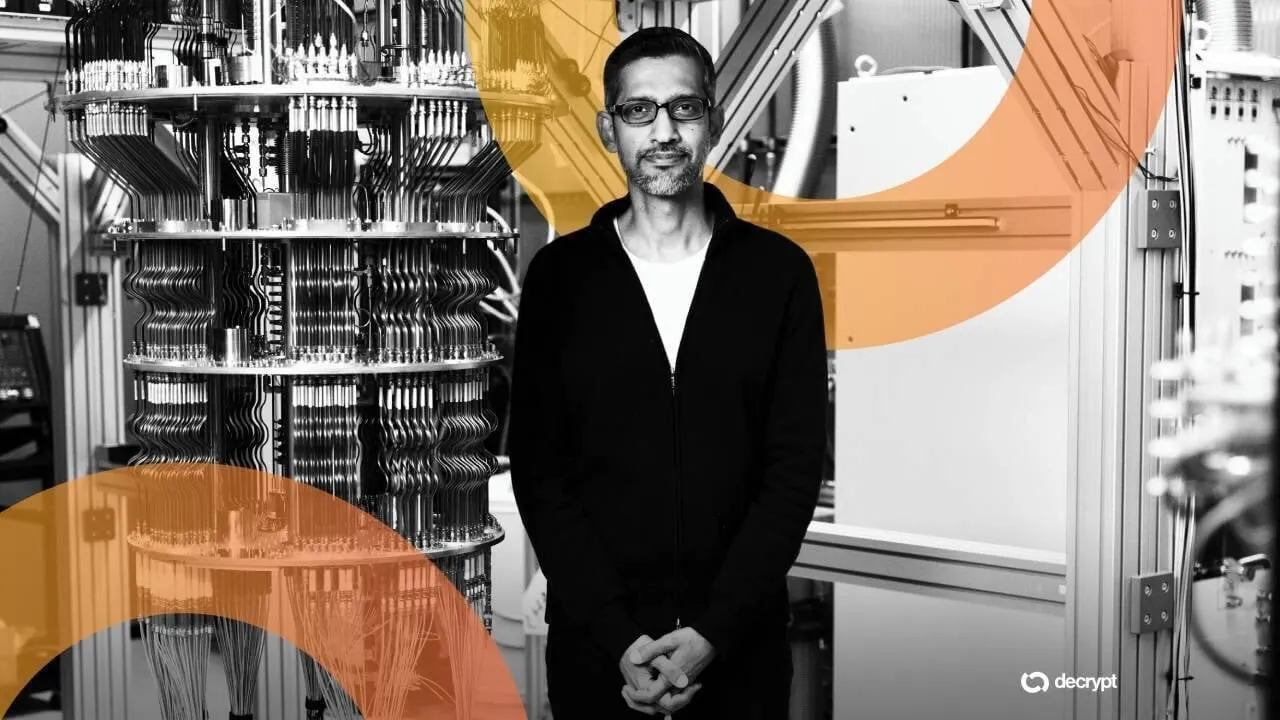In brief
- Google’s Willow chip achieved a verified quantum speed-up confirmed by experiment.
- Verified results mark a step toward fault-tolerant quantum systems with real-world impact.
- Experts warn that such progress could eventually threaten Bitcoin’s elliptic-curve encryption.
Google’s latest quantum processor has achieved what physicists have pursued for decades: a verified speed-up over the world’s best supercomputers. And that makes the anticipated threat against Bitcoin appear even bigger than ever.
In a study published in Nature on Wednesday, the company’s 105-qubit Willow chip ran a physics algorithm faster than any classical machine could simulate—a first experimentally confirmed quantum advantage achieved with real hardware.
The peer-reviewed results are narrow, but consequential. It confirms that quantum processors are inching toward the reliability needed for practical use—and with it, the possibility that one day, they could break the encryption protecting Bitcoin and other digital assets.
While that threat remains distant, every verified leap in quantum performance brings the “quantum threat” timeline closer into focus for crypto builders and investors alike.
Last year, we introduced Willow, our quantum chip, and cracked a key challenge in quantum error correction.
Today, @GoogleQuantumAI announced a new breakthrough algorithm on that chip which paves a path towards potential future uses in drug discovery and materials science.🧵 pic.twitter.com/7z3BSExVku
— Google (@Google) October 22, 2025
According to the report, Google’s Quantum Echoes algorithm ran about 13,000 times faster on Willow than classical simulations could achieve, completing a task in just over two hours that would take roughly 3.2 years on Frontier—one of the world’s fastest publicly benchmarked supercomputers.
“The result is verifiable, meaning its outcome can be repeated by other quantum computers or confirmed by experiments,” Google CEO Sundar Pichai wrote on X. “This breakthrough is a significant step toward the first real-world application of quantum computing, and we’re excited to see where it leads.”
How the experiment worked
Researchers tested Willow by running a series of time-reversal experiments and watching how quantum information spreads and refocuses across the chip’s qubits. They first drove the system forward through a set of quantum operations, then disturbed one qubit with a controlled signal, and finally reversed the sequence to detect whether the information would “echo” back.
That echo appeared as constructive interference, where quantum waves reinforced one another instead of canceling out—a clear sign of quantum behavior. The circuits involved were too complex for classical computers to simulate exactly.
Willow’s superconducting transmon qubits held up through the process, showing median two-qubit gate errors around 0.0015 and coherence times above 100 microseconds. Those stability levels allowed researchers to run 23 layers of quantum operations across 65 qubits, pushing beyond what classical models can currently reproduce.
What is Willow?
Unveiled in December 2024, Willow is Google’s latest superconducting quantum processor, built to demonstrate more stable, verifiable quantum behavior than its predecessors. It follows the 2019 Sycamore experiment, which showed that a quantum processor could outperform classical supercomputers but couldn’t be reliably reproduced.
Willow closes that gap: its improved error correction keeps qubits coherent for longer, allowing experiments that can be repeated and verified within the same device.
While the work remains at a research scale, it shows that quantum interference can persist in systems too complex for classical simulation—a measurable advance in the long-running effort to make quantum computing both reproducible and practical.
Toward real-world use
Google said its next goal was to move quantum computing from controlled demonstrations to practical science, including modeling how atoms and molecules interact—simulations far beyond the reach of classical computers, noting a recent proof-of-principle experiment with the University of California, Berkeley.
In a statement, Google described the work as an early step toward a potential tool for mapping molecular structures, designing new drugs, and developing advanced materials for batteries and quantum hardware itself.
“Just as the telescope and the microscope opened up new, unseen worlds, this experiment is a step toward a ‘quantum-scope’ capable of measuring previously unobservable natural phenomena,” they wrote.
Why it matters for Bitcoin
For now, Willow’s achievement doesn’t endanger encryption. But its verification marks steady progress toward the kind of quantum machine that could.
Bitcoin and other digital systems depend on elliptic-curve cryptography—mathematical functions that are effectively impossible for classical computers to reverse-engineer, but theoretically vulnerable to a sufficiently powerful quantum computer.
“Quantum computation has a reasonable probability—more than five percent—of being a major, even existential, long-term risk to Bitcoin and other cryptocurrencies,” Christopher Peikert, professor of computer science and engineering at the University of Michigan, told Decrypt. “But it’s not a real risk in the next few years; quantum-computing technology still has too far to go before it can threaten modern cryptography.”
Peikert said Bitcoin isn’t immune to quantum attacks, though the threat remains distant. Transitioning to post-quantum signature schemes, he added, would also bring trade-offs in size and performance.
“Keys and signatures are much larger,” Peikert said. “Because cryptocurrencies rely on many signatures for transactions and blocks, adopting post-quantum or hybrid schemes would significantly increase network traffic and block sizes.”
The quiet countdown
Simulating Willow’s circuits with tensor-network algorithms would take more than 10⁷ CPU-hours on Frontier, the world’s fastest supercomputer. That gap—two hours of quantum computation versus several years of classical simulation—stands as the clearest experimental proof yet of device-level quantum advantage.
Even with replication still pending, Willow marks a shift from theory to testable engineering: a system performing a real calculation beyond the reach of classical machines. For cryptographers and developers alike, it’s a reminder that post-quantum security isn’t a distant problem anymore—it’s a clock that’s already started ticking.

